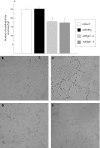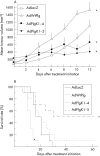Plasminogen fragment K1-5 improves survival in a murine hepatocellular carcinoma model
- PMID: 16809420
- PMCID: PMC1856779
- DOI: 10.1136/gut.2005.088583
Plasminogen fragment K1-5 improves survival in a murine hepatocellular carcinoma model
Abstract
Background: The prognosis of patients with hepatocellular carcinoma (HCC) remains poor, and new alternative treatments are needed.
Aims: To comparatively test the angiostatic and antitumour effects of adenoviral gene transfer of angiostatin (PlgK1-4, amino acids 1-440) and full kringles 1-5 (PlgK1-5, amino acids 1-546) in a model of subcutaneously transferred HCC in mice.
Methods: PlgK1-4 and PlgK1-5 were generated from human WtPlg cDNA and used for adenovirus construction. Vector function and angiostatic effects were confirmed in vitro and in vivo. Antitumoral efficacies of intratumoral vector injections were studied in a model of subcutaneously transferred HCC model.
Results: Cell supernatants containing PlgK1-4 and PlgK1-5 reduced endothelial tube formation in vitro by about 30%, whereas WtPlg exerted no inhibitory effect. Endothelial cell infiltration in vivo was decreased by about 60%, but not in AdWtPlg-treated animals. Intratumoral treatment of subcutaneous HCC tumours inhibited growth by 40% for AdPlgK1-4 and 63% for AdPlgK1-5 in surviving mice 12 days after initiation of treatment, whereas treatment with AdWtPlg even led to accelerated growth. Although PlgK1-4 and PlgK1-5 have similar inhibitory effects on intratumoral microvessels, PlgK1-5 markedly improved the survival time compared with PlgK1-4.
Conclusion: PlgK1-5 and PlgK1-4 effectively inhibited HCC growth. As PlgK1-5 could also prolong the survival time, inducing complete tumour elimination in half of the AdPlgK1-5-treated mice, PlgK1-5 might be the most potential plasminogen fragment for treatment of experimental HCC.
Conflict of interest statement
Competing interests: None.
References
-
- Carr B I. Hepatocellular carcinoma: current management and future trends. Gastroenterology 2004127(Suppl 1)S218–S224. - PubMed
Publication types
MeSH terms
Substances
LinkOut - more resources
Full Text Sources
Other Literature Sources
Medical
Research Materials





